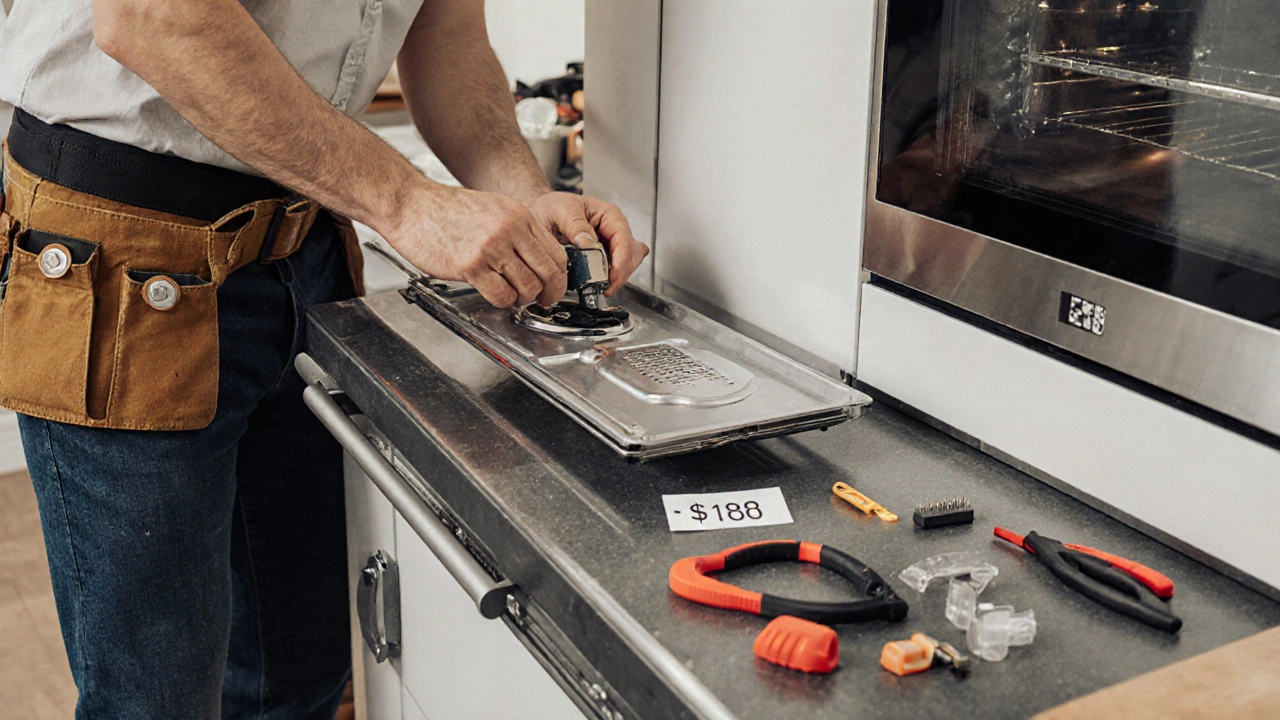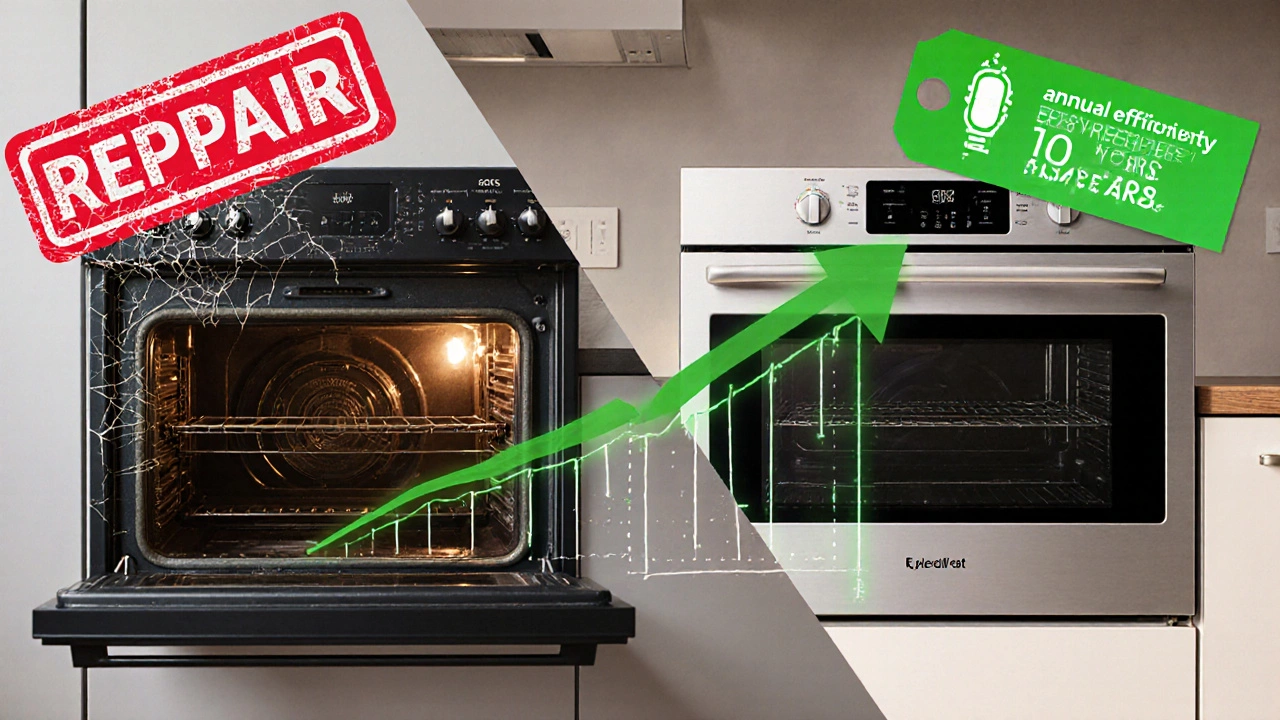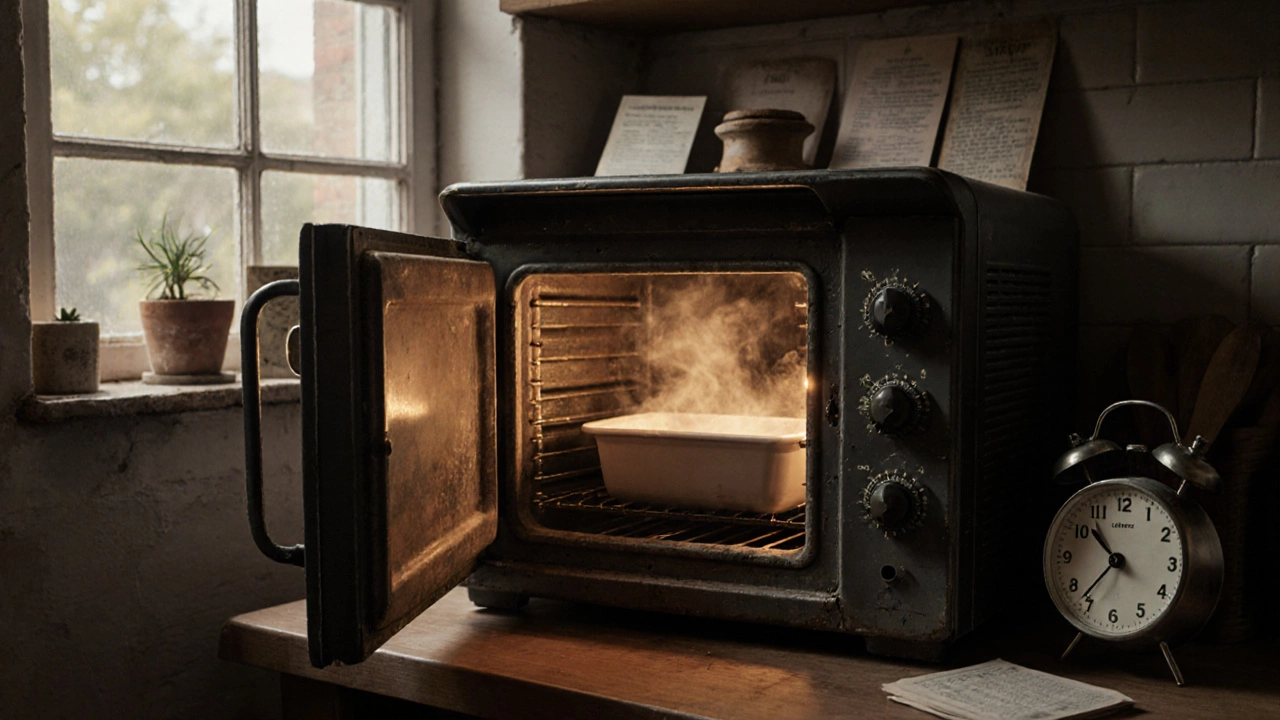Oven Repair vs Replacement Cost Calculator
Cost Comparison Calculator
Find out if repairing your 20-year-old oven makes financial sense or if it's time to replace it.
Repair cost is of new oven cost.
Recommendation:
- Repair cost: $
- New oven cost: $
- 5-year energy savings: $
- 10-year energy savings: $
You’ve been cooking with the same oven for two decades. It’s seen birthday cakes, burnt toast, and countless roast dinners. Now it’s acting up-maybe the heating element flickers, or the thermostat won’t hold temperature. You’re staring at the repair quote and wondering: is it worth fixing a 20-year-old oven?
How long do ovens really last?
Most electric ovens are built to last 15 to 20 years. That’s not a guess-it’s what manufacturers design for, and what repair technicians see in the field. If yours hit 20, you’ve already beaten the average. That doesn’t mean it’s broken beyond hope. It just means you’re in the final stretch.
Some ovens last longer. I’ve seen 30-year-old models still working in heritage homes in Wellington, mostly because they were built with thicker steel, simpler electronics, and fewer fancy features. But those are exceptions. Most ovens made after 2000 use cheaper parts, plastic components, and circuit boards that fail faster than the old mechanical timers and thermostats.
What’s wrong with your oven?
Not all problems are equal. Some fixes are cheap and easy. Others are a money pit.
- Heating element failure - Common. Costs $50-$120 for the part, plus labor. Easy fix. Worth doing.
- Thermostat or temperature sensor - If your oven runs too hot or too cold, this could be it. Sensor replacement is $80-$150 total. Often fixes the issue completely.
- Igniter or relay board - If the oven won’t turn on at all, it might be a control board issue. These cost $200-$400 to replace. At 20 years old, this is a red flag.
- Door seal or hinge - Leaky heat? A new gasket costs $30 and takes 20 minutes. Always fix this.
- Multiple issues at once - If the element, sensor, and control panel are all failing? You’re not repairing. You’re throwing money at a sinking ship.
Here’s a rule of thumb: if the repair cost is under 50% of a new oven’s price, and the oven is still in decent shape otherwise, go ahead. If it’s over 50%, or if the same part failed twice in the last year, walk away.
What does a new oven cost in 2025?
A basic, reliable electric oven in New Zealand runs $800-$1,200 installed. Mid-range models with convection, self-cleaning, and smart features start at $1,500. High-end built-ins can hit $3,000.
But here’s what most people forget: installation isn’t free. If your old oven was hardwired, and the new one needs a different plug or circuit upgrade, that’s another $200-$500. If your cabinetry is custom, or the opening needs trimming, add more.
Compare that to a repair: $150-$400 for parts and labor. Even at the high end, that’s still less than half the cost of replacement.
Energy efficiency: The hidden cost of an old oven
Old ovens are energy hogs. A 20-year-old model might use 30-40% more electricity than a modern one. That adds up over time.
Let’s say your oven runs 2 hours a week. At 2.5 kW per hour, that’s 5 kWh weekly. A modern oven uses about 1.8 kW. That’s 1.4 kWh saved per use. Over a year, that’s 72.8 kWh saved. At 30 cents per kWh in New Zealand, that’s $21.84 a year in electricity savings.
That doesn’t sound like much. But over five years? $109. Over ten? $218. That’s not enough to pay for a new oven-but it’s not pocket change either. If you cook often, or if power prices keep rising, efficiency becomes a real factor.

Reliability and peace of mind
Think about the last time your oven died mid-bake. Was it Christmas Eve? A dinner party? A Sunday roast? That’s not just wasted food-it’s stress, time, and embarrassment.
A 20-year-old oven might work today, but it’s like a car with 300,000 km on the odometer. It’s not going to fail tomorrow. But it might fail next week. Or next month. And when it does, you’ll be scrambling to find a replacement in a hurry.
New ovens come with at least a one-year warranty. Some brands offer two or three. Repairs? You get 90 days, maybe. That’s not the same kind of security.
When to fix it
Fix your 20-year-old oven if:
- The problem is a single, simple part (element, sensor, door seal)
- The repair costs less than $300
- The oven still heats evenly and looks decent
- You’re not planning to move or renovate soon
- You’re on a tight budget and can’t afford a new one right now
When to replace it
Replace your oven if:
- The control board or main circuitry is failing
- Multiple parts have failed in the last year
- The repair quote is over $400
- You’re tired of waiting for it to heat up or worrying it’ll die during dinner
- You’re renovating your kitchen anyway
- You want smart features, faster preheating, or better energy ratings

What to do right now
Don’t rush. Here’s your next step:
- Identify the exact problem. Does it heat? Does it hold temp? Does it turn on at all?
- Get one repair quote from a local technician. Ask for a breakdown: parts cost, labor, warranty.
- Visit a kitchen appliance store. Look at entry-level electric ovens. Note the price, features, and installation cost.
- Compare the two numbers. If repair is under half the replacement cost, and the oven works well otherwise, fix it.
- If repair is close to or over half the cost, or if you’ve had multiple repairs in the last two years, start shopping for a new one.
There’s no magic number. But if you’ve already spent $800 on repairs over the last five years, and your oven still takes 20 minutes to preheat? It’s time.
What about secondhand or refurbished ovens?
Some people buy used ovens from eBay or local classifieds. They’re cheap-$200-$400. But here’s the catch: they’re often older than your current oven. No warranty. No guarantee. And if it breaks in a month, you’re back to square one.
Refurbished ovens from appliance retailers are better. They come with a 12-month warranty, tested components, and sometimes even new door seals. Prices range from $600-$900. If you’re not ready to spend $1,200, this is a smart middle ground.
Final call: Is it worth fixing?
Yes-if it’s a simple fix, and you’re happy with how it works. No-if the repair is expensive, the oven is unreliable, or you’re tired of the hassle.
Your oven has served you well. But appliances aren’t sentimental. They’re tools. And when a tool stops doing its job efficiently, it’s time to let it go.
Don’t fix it because you feel guilty. Don’t replace it because you’re bored. Do it because the numbers make sense-and your peace of mind matters more than you think.
Can a 20-year-old oven be safely repaired?
Yes, if the issue is a simple component like a heating element, thermostat, or door seal. These parts are still made and available. But if the control board or wiring is damaged, repairs become risky. Older wiring may not meet current safety standards, and outdated electronics can fail unpredictably. Always have a licensed technician inspect the unit before proceeding.
How much does it cost to repair an old oven?
Basic repairs like replacing a heating element or temperature sensor cost $150-$250. More complex issues, like a faulty control board, can run $300-$500. Labor typically runs $80-$120 per hour. Always ask for a written quote before work begins. Avoid technicians who charge just to diagnose-it’s a red flag.
Is it cheaper to repair or replace a 20-year-old oven?
It depends. If the repair costs under $400 and the oven works well otherwise, repairing is cheaper. But if the repair is over $400, or if you’ve had multiple repairs in the last few years, replacement is usually the better value. A new oven costs $800-$1,200 installed, but comes with a warranty, better efficiency, and fewer surprises.
Do modern ovens use less electricity?
Yes. Modern electric ovens are 25-40% more energy-efficient than models from the early 2000s. Better insulation, precise thermostats, and faster preheating reduce power use. Over five years, that can save you $100-$200 on electricity bills. If you cook often, this adds up.
Should I buy a refurbished oven instead of a new one?
Refurbished ovens from reputable retailers are a good option if you want to save money. They’re tested, cleaned, and come with at least a 12-month warranty. Prices range from $600-$900. Avoid secondhand ovens from private sellers-they often have hidden damage and no warranty. A refurbished unit gives you reliability without the full new price.

